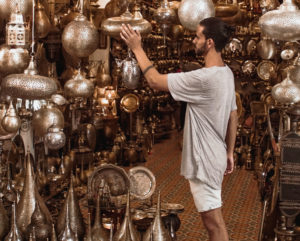Lying 14 kilometers, or 9 miles, from the southern coast of Spain, the North African country gathers Middle Eastern magic, European flair and Berber tradition.
Tourism has more than doubled since 2000, to nearly 14 million visitors in 2019. King
The royal ruler’s strategy is supported by infrastructure development, which make traveling around the country even easier.
Add to this a program of ongoing social, economic and political reforms, and Morocco is one of the most m peaceful and moderate countries in the region.
Here are 10 things you will want to know before you arrive:
1. The Food is Bloody Amazing

If you want to lose weight? Then forget about Morocco you will discover one of the best worlds gastronomy. Morocco’s national dish is the Tageene – a hearty North African stew combining chicken, lamb, or fish with potatoes, carots, peas, , nuts and spices like ginger, saffron, as well as cinnamon that typically cost around $3 to $6.
2. Most mosques are off-limits to non-Muslims.
Almost 99% of the population is Muslim, and hearing the Mouaddin’s melodic call to prayer for the first time is a spine-tingling instant.
While very few mosques in Morocco are open to Non-Muslim tourists, one exception is the towering Hassan 2 Mosque in Casablanca Located on a headland over the Atlantic Ocean, the mosque was completed in 1992 and can hold more than 100,000 worshipers inside and out.

Technology and Tradition sit side by side, with colorful zeleej (mosaic tiles) and carved cedar complementing the retractable roof and heated flooring.
Marrakesh’s 16th-century Ali ben Youssef madrassa-turned-museums is open to all and also features impressive Islamic design.
3. Multilingual Moroccans will put you to shame.
Moroccans switch languages mid-sentence, reflecting their cultures – Arab, Berber, French and Spanish — that have traversed the country.
Arabic language is the official language, and you will hear the Moroccan dialect, Dareeja, spoken on the street.
French continues to be commonly spoken in cities; foreigners are often addressed in this first. Spanish is still spoken in the north of the countrie.
There are also three dialects spoken by the country’s Berber majority: Tamazight, Tashelhit, and Tarifit.
4. Do not get stuck in Marrakesh.

Marrakesh is the most popular in Morocco, but there is so much more.
Fez tops the list for its maze-like old medina, fabulous gourmand scene and the annual Festival of World Sacred Music.
For a part of the Sahara, there is the Saharian town of Merzouga, near the impressive Erg Chebi sand dunes, accessible via camel treks.
Active people can hike between Berber villages in the High Atlas montain or head to the blue town of Chefchaouen to explore the Rif Mountains.
Beach fans will love Agadir and Essaouira on the Atlantic coast, while surfers often head to Taghazout.
Moulay Idriss, Morocco’s holiest town, is hard to beat for quiet contemplation,. Plus, you will have the nearby Roman ruins of Volubilis pretty much to yourself.
5. Riads much better than Hotels.

Riad is a traditional Moroccan house, built around a central courtyard with windows facing inside for privacy.
They are decorated out with elaborate zeleej, stucco and painted cedar and are definitely the most atmospheric places to stay.
6. Morocco is Home to the World First University

The university of Al-Qaraouiyin in Fez, is the world’s first university. It was founded in 859 AC and it’s still operating today. The founder was an intellectual and powerful Moroccan woman called Fatima Al-Fihria who wanted to give moroccans equal access to science and religious studies.
7.The old Medinas, Full of Treasures and Original Handicrafts

Morocco is known for its old Medinas, which are cities’ historical downtowns and the place to find the best traditional handicrafts.All Moroccan handicrafts, like rugs, jewelry, leather and pottery items can be found in the Medina. They are habitually made by craftsmen who are passionate about their job and who inherited their skills from their parents.
8. do not miss the sweet orange juice
One thing you will certainly should not miss, is a daily Vitamin C fill. You will find fresh squeezed orange juice just about everywhere when you travel Morocco, Are you ready for the best part? It’s only 5 DH ($.50)! You can actually find a diversity of fresh juices all around, including avocado and banana juice.


